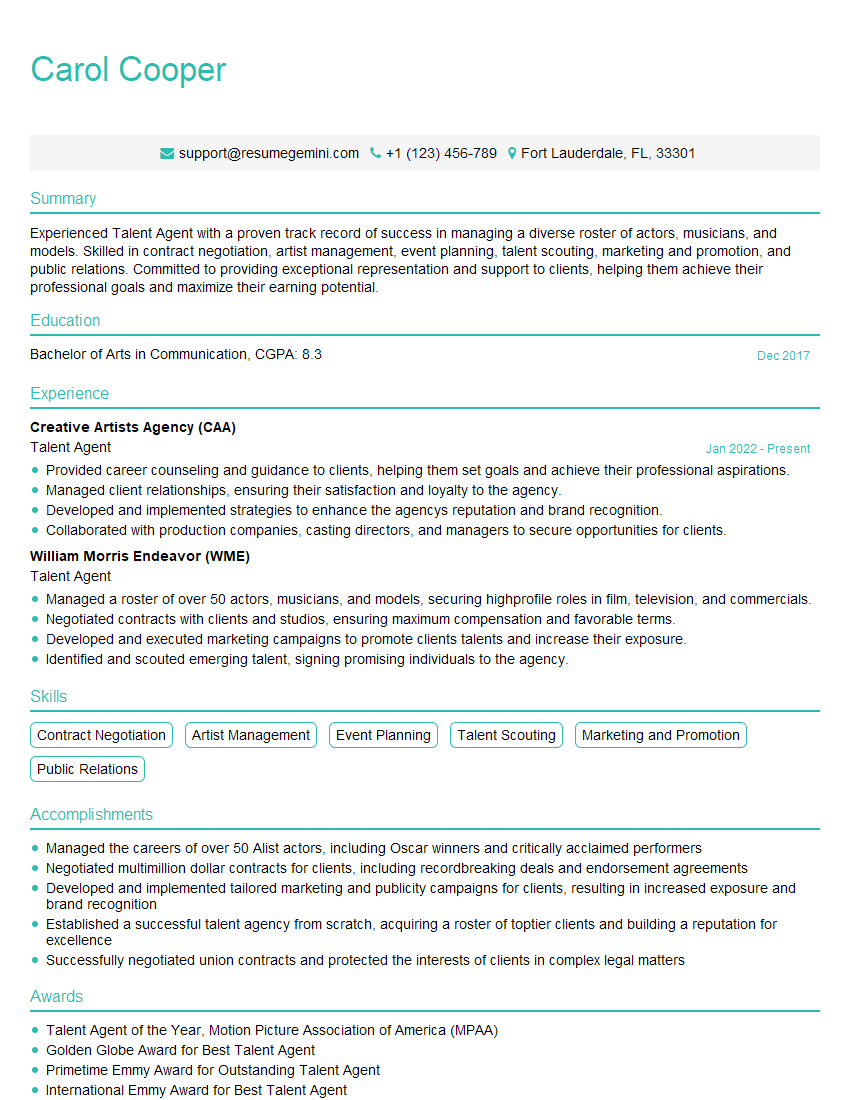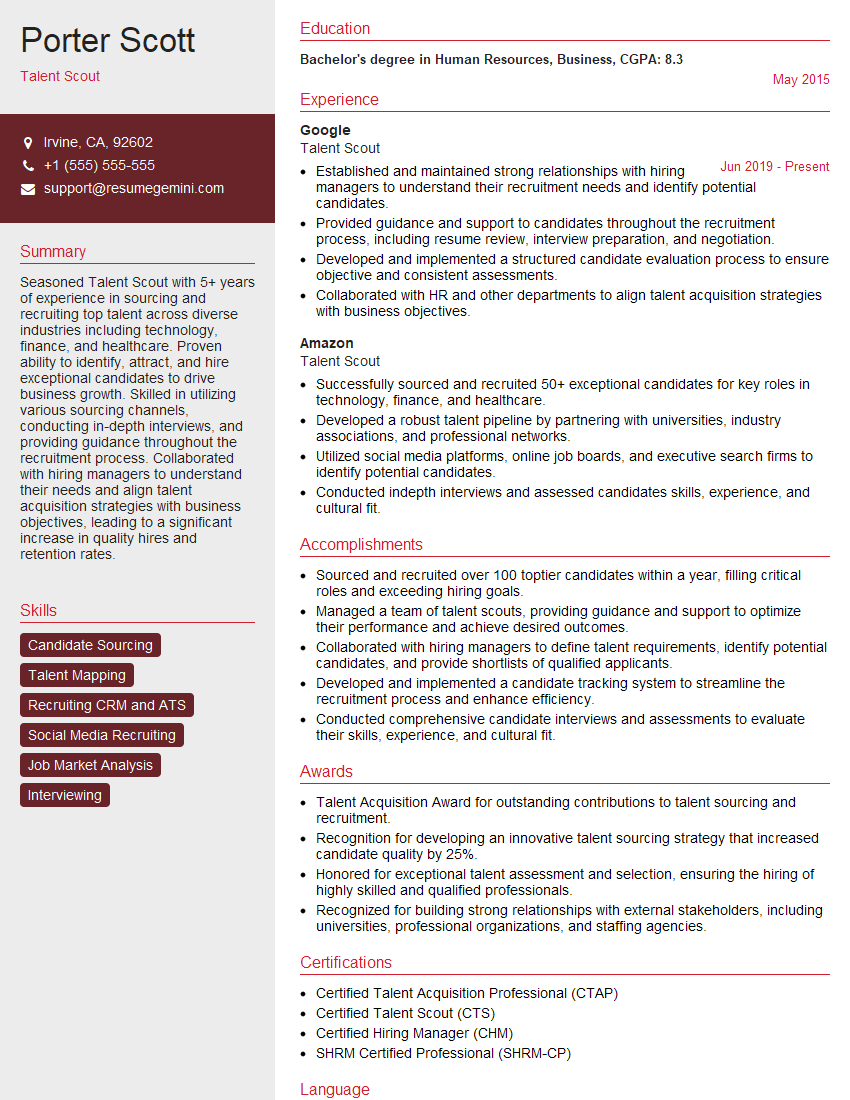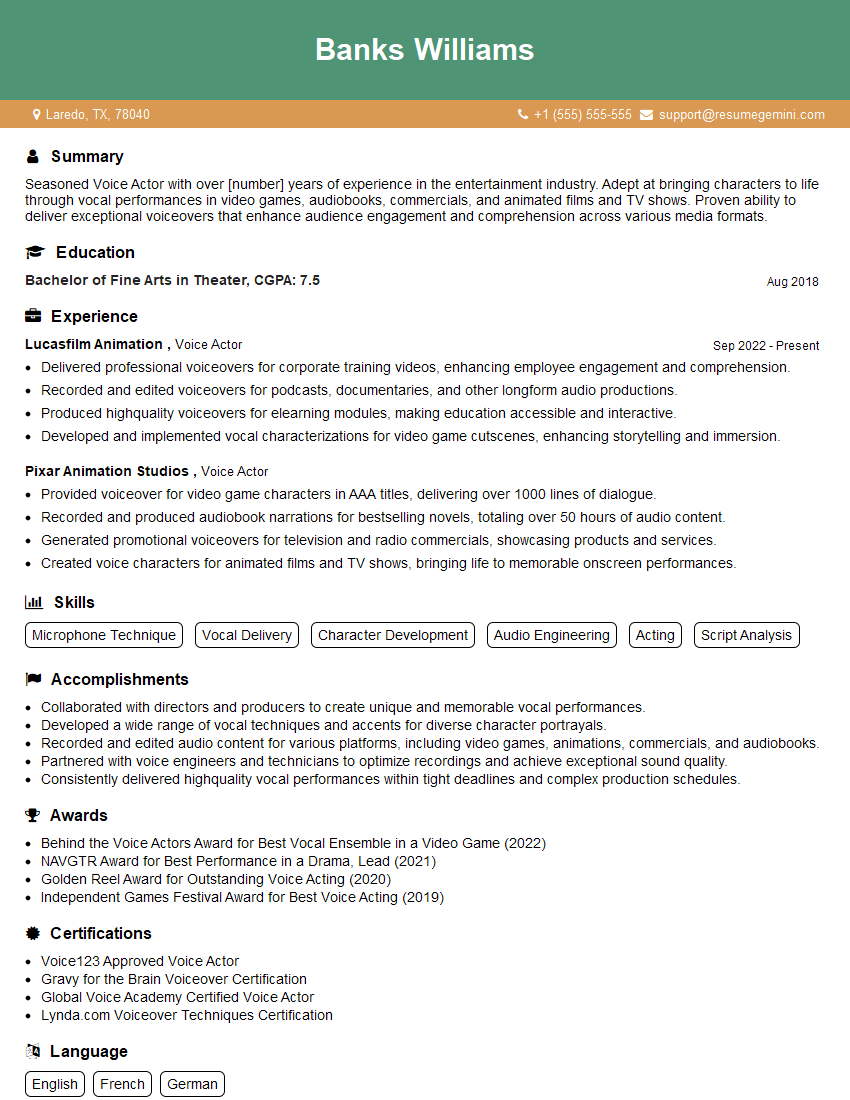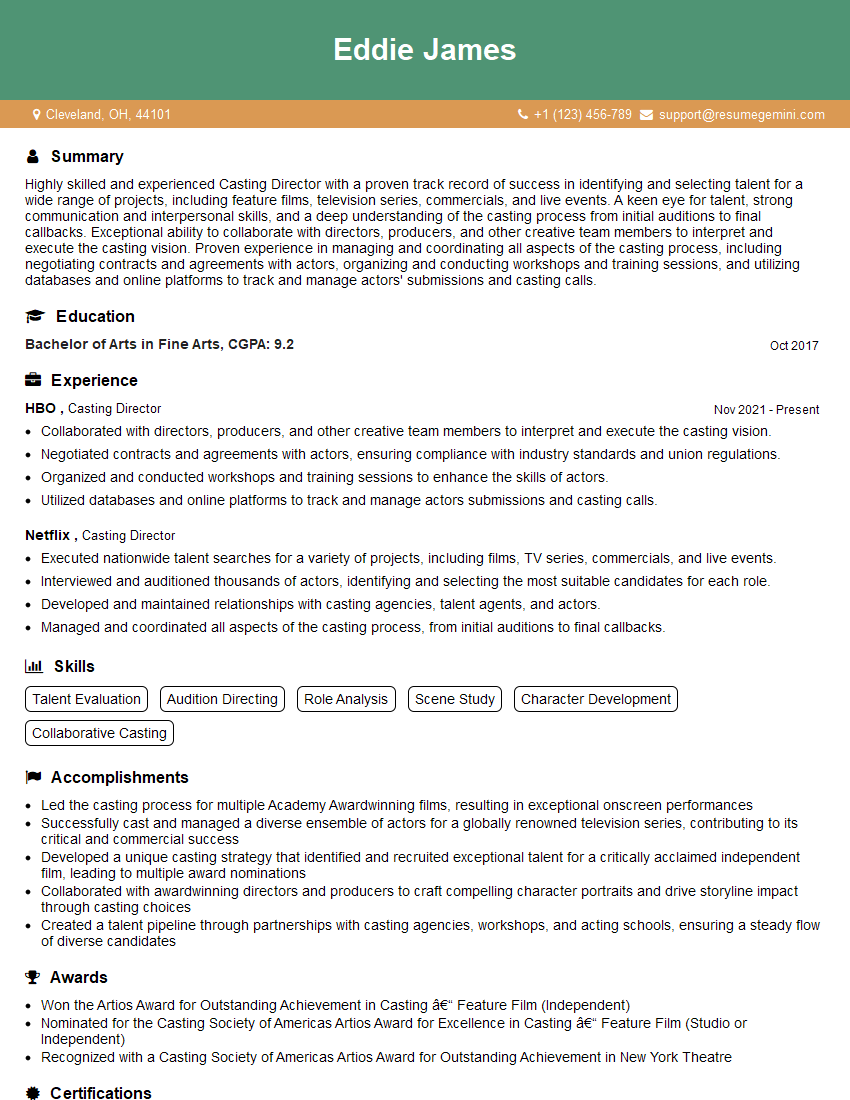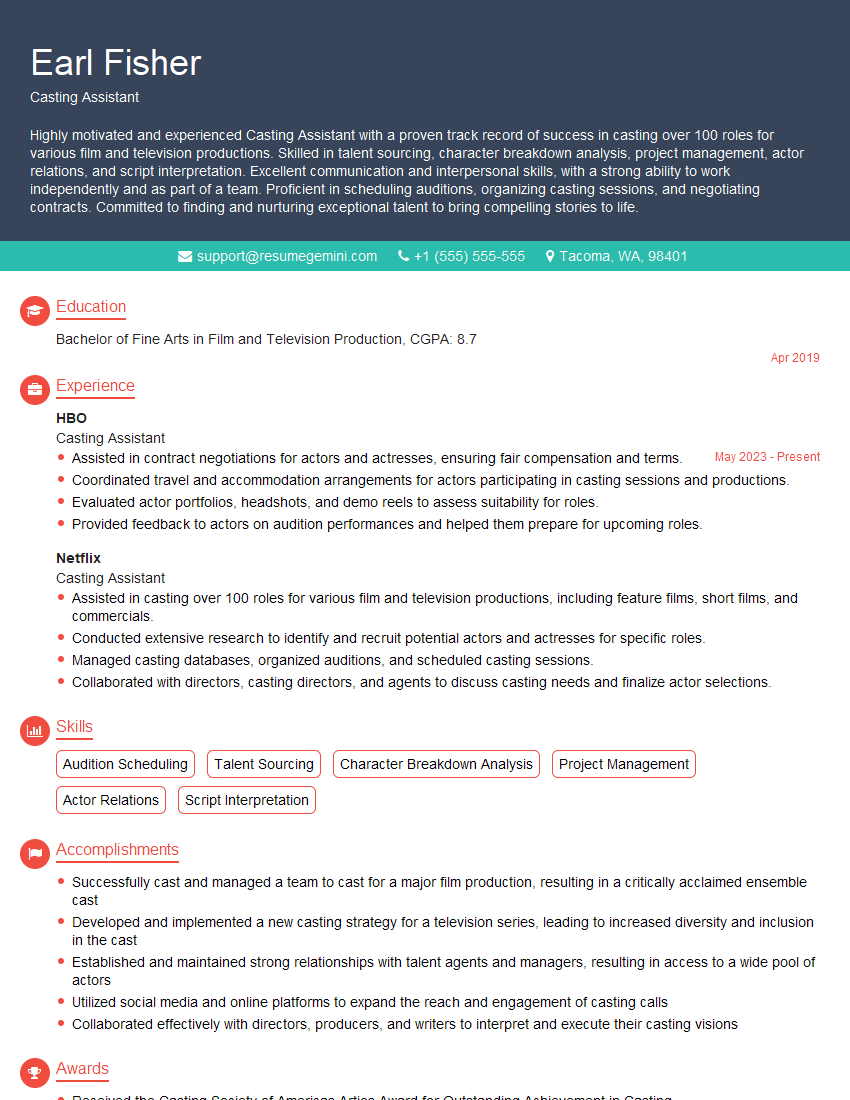Are you ready to stand out in your next interview? Understanding and preparing for Audition Technique interview questions is a game-changer. In this blog, we’ve compiled key questions and expert advice to help you showcase your skills with confidence and precision. Let’s get started on your journey to acing the interview.
Questions Asked in Audition Technique Interview
Q 1. Explain your approach to preparing for an audition.
My audition preparation is a multi-stage process, prioritizing thorough understanding and confident execution. It begins with a deep dive into the script itself, understanding the character’s arc, motivations, and relationships. Next, I research the project – the director’s previous work, the overall tone of the piece, and the target audience. This informs my interpretation and ensures my performance aligns with the project’s vision. I then work on vocal and physical preparation, practicing vocal exercises to ensure clarity and range, and experimenting with physicality to capture the character’s essence. Finally, I rehearse extensively, focusing on both memorization and nuanced performance choices, often recording myself to identify areas for improvement. This systematic approach ensures I’m not only ready but confident and prepared to showcase my best work.
Q 2. How do you analyze a script for an audition?
Analyzing a script is crucial. I start by identifying the character’s objectives – what they want and need within the scene. I look for subtext – the unspoken intentions and emotions underlying the dialogue. I analyze the relationships between characters, understanding the dynamics and power balances at play. The setting and time period also influence my interpretation. For example, a scene in a bustling marketplace will demand a different energy than one in a quiet library. I also consider the overall arc of the story, to ensure my character’s contribution fits seamlessly into the larger narrative. Essentially, I aim to create a detailed character map, understanding every facet of their personality and their function within the script.
Q 3. Describe your method for creating a compelling character.
Creating a compelling character is a process of discovery and embodiment. I begin with the script’s provided information, but I go beyond that by building a backstory – their upbringing, past experiences, relationships, and personal flaws. I think about their physicality – how they move, their posture, their gestures. I also consider their voice – their tone, accent, and rhythm. To bring depth, I focus on their internal life – their motivations, fears, and desires. One technique I use is ‘sense memory’ – recalling personal experiences to access similar emotions. For instance, if my character is experiencing grief, I might recall a personal loss to inform my portrayal. It’s about inhabiting the character’s skin, not just reciting lines.
Q 4. What techniques do you use to manage nerves before an audition?
Audition nerves are a common experience, but manageable. My strategy is a combination of preparation and mindfulness. Thorough preparation eliminates a major source of anxiety – the fear of being unprepared. Before an audition, I engage in relaxation techniques like deep breathing exercises or meditation. I also try to visualize a successful audition, focusing on positive self-talk and building my confidence. Sometimes, I’ll listen to calming music or engage in a light physical activity to release tension. And importantly, I remind myself that the casting director wants me to succeed; they are looking for talent, and my nerves don’t reflect my abilities.
Q 5. How do you adapt your performance to different casting directors’ styles?
Adapting to different casting directors is about being observant and flexible. Before an audition, I try to learn about the casting director’s style – do they prefer a more naturalistic or heightened approach? I might research their past casting choices or watch videos of their previous auditions. During the audition, I pay close attention to their cues – their body language and verbal feedback. Am I being asked to adjust my performance? Are they responding positively to certain choices? I adjust my approach accordingly, always aiming to be responsive and collaborative. The goal isn’t to become a chameleon, but to be versatile enough to meet the needs of the specific director and project.
Q 6. Explain your understanding of cold reading techniques.
Cold reading requires quick thinking and adaptability. It’s about understanding the scene’s context instantly and portraying believability in a spontaneous manner. My approach starts with a quick scan of the script – understanding the story’s premise, character relationships, and the overall tone. Then, I focus on the text itself, looking for clues about my character’s personality, goals, and emotions. I try to deliver the lines clearly and with conviction, even if I’m unsure of my character’s full backstory. It’s important to be present and listen attentively. If possible, I try to create a subtle connection with the other actors involved, to enhance the authenticity of the scene. It’s an exercise in improvisation grounded in an understanding of the text.
Q 7. How do you handle constructive criticism from a director?
Constructive criticism is invaluable for growth. My approach is to listen actively, without interruption. I ask clarifying questions if anything is unclear. I avoid becoming defensive and instead focus on understanding the director’s perspective. I take notes, reflecting on the feedback later. I consider how I can use this criticism to refine my performance and apply the insights to future auditions. It’s about recognizing that the director’s goal is to help me reach my full potential. Their feedback isn’t a personal attack, but a professional evaluation aimed at improving the overall performance. Even negative feedback can be a stepping stone to improvement.
Q 8. Describe your experience working with a script supervisor.
Working with a script supervisor is crucial for a smooth audition process. They’re the keeper of continuity, ensuring every detail – from props and wardrobe to blocking and line readings – remains consistent. My experience involves actively collaborating with them. I listen carefully to their notes on line readings, blocking suggestions, or any specific requests regarding character interpretation. For instance, on a recent audition for a period piece, the script supervisor pointed out a subtle change in my character’s posture during a key scene that helped enhance the emotional arc. I immediately adjusted my performance based on her input and it made a significant difference. This collaborative approach guarantees a polished and professional performance, demonstrating respect for the craft and the overall production process.
Q 9. How do you choose the right material for your audition?
Choosing the right audition material is paramount. It needs to showcase your strengths while fitting the role’s requirements. My approach involves a three-step process: First, I carefully analyze the casting notice, paying close attention to the character’s personality, age range, and the overall tone of the project. Secondly, I search for pieces that allow me to demonstrate a range of emotions and skills relevant to the part. I might choose a monologue that exhibits comedic timing or one that demands intense emotional depth, depending on the role’s demands. Thirdly, I carefully consider the length; it needs to be compelling and impactful within the allotted audition time, typically avoiding anything too long or too short. For example, if it’s a comedic role, I’d select a piece that highlights my comedic delivery and timing; if it’s a dramatic role, a monologue showcasing my ability to portray vulnerability or strength would be appropriate.
Q 10. Explain your approach to physical preparation for an audition.
Physical preparation for an audition is as important as vocal preparation. It begins with understanding the character physically. Is the character athletic, frail, or somewhere in between? This informs my physical approach. I might incorporate light exercise to improve posture and energy levels or targeted stretches to enhance flexibility and movement, depending on the role’s demands. For example, for a physically demanding role, I might spend extra time at the gym. Equally important is ensuring I am well-rested and hydrated. A tired body and mind will affect my performance. I also focus on ensuring my clothing is appropriate and comfortable, allowing me to move freely and focus on the performance rather than worrying about my attire. This holistic approach ensures I present myself confidently and authentically.
Q 11. How do you handle unexpected technical difficulties during an audition?
Unexpected technical difficulties are a reality in auditions. My approach prioritizes calm problem-solving. If the microphone malfunctions, I’ll politely alert the casting director and suggest solutions, such as moving closer to the existing microphone or providing alternatives if possible. If the technology fails entirely, I remain composed, acknowledging the situation professionally. It’s crucial to avoid letting frustration show. Instead, I’ll proactively offer to continue without the technology if possible, demonstrating my adaptability and commitment. In one instance, during an online audition, the internet connection dropped; I remained calm, explained the situation, and successfully rescheduled the audition. Maintaining professionalism during adversity demonstrates resourcefulness and a positive attitude.
Q 12. How do you showcase your vocal range and flexibility?
Showcasing vocal range and flexibility involves strategic piece selection and performance technique. I’ll choose material that allows me to demonstrate the full spectrum of my voice, from low registers to high notes, using a variety of vocal textures. I might select a song or monologue that involves contrasting emotions, allowing me to transition between different vocal styles. My performance incorporates clear articulation, dynamic range, and control to showcase my vocal skills and versatility. I will use vocal exercises beforehand to warm up my voice. This prepares me to execute complex vocal parts without strain or cracking, providing a professional and polished demonstration of my vocal abilities.
Q 13. Describe your method for creating believable character relationships.
Creating believable character relationships involves a thorough understanding of both characters’ motivations, backstories, and their relationship dynamics. I start by analyzing the script, identifying the core conflict and the nature of the relationship. I explore their shared history, the specific events that shaped their interactions, and their unspoken desires and grievances. Then, I develop a backstory for my character that fully explains their behaviour in relation to the other characters. I explore each character’s unique perspective, avoiding judgment and allowing myself to fully empathize with their point of view. For example, before auditioning for a scene portraying sibling rivalry, I meticulously explored the possible dynamics of sibling relationships, including their history of love, hatred, and competition. The result was a nuanced portrayal of a believable, complex relationship.
Q 14. How do you maintain professionalism in demanding audition environments?
Maintaining professionalism in demanding audition environments involves a combination of preparation and attitude. Arriving on time, dressed appropriately, and having my materials ready demonstrates respect for everyone’s time. I remain positive and enthusiastic, even if waiting times are long or the environment is stressful. I treat every person I encounter, from casting directors to assistants, with courtesy and respect. Maintaining eye contact, actively listening, and providing thoughtful answers reflect my dedication. Furthermore, taking constructive criticism graciously and responding thoughtfully is a key part of maintaining professionalism. This positive, respectful approach consistently creates a professional environment, regardless of the audition’s circumstances.
Q 15. How do you prepare for a callback audition?
A callback audition is a significant step, indicating the casting director sees potential. My preparation intensifies. First, I review notes from the initial audition, focusing on what worked and what needs improvement. I rewatch any recorded material, analyzing my performance objectively. Then, I delve deeper into the character’s backstory, motivations, and relationships. I might research similar roles or explore different interpretations of the script. This phase often involves vocal and physical exercises to refine my delivery and embodiment of the character. Finally, I rehearse thoroughly, preparing various options for certain lines or scenes, allowing for flexibility during the callback. I also practice responding to potential directorial adjustments. Think of it like this: the initial audition is the first impression; the callback is the opportunity to show depth and versatility.
Career Expert Tips:
- Ace those interviews! Prepare effectively by reviewing the Top 50 Most Common Interview Questions on ResumeGemini.
- Navigate your job search with confidence! Explore a wide range of Career Tips on ResumeGemini. Learn about common challenges and recommendations to overcome them.
- Craft the perfect resume! Master the Art of Resume Writing with ResumeGemini’s guide. Showcase your unique qualifications and achievements effectively.
- Don’t miss out on holiday savings! Build your dream resume with ResumeGemini’s ATS optimized templates.
Q 16. Explain your process for receiving and acting upon feedback.
Feedback is crucial. I listen actively, taking notes rather than interrupting or immediately arguing. I try to understand the feedback from the perspective of the director or casting director – what are their specific needs and expectations? I categorize feedback: is it about technical aspects (vocal projection, pacing), emotional delivery, or character interpretation? Once I understand it, I experiment with different approaches. For example, if I’m told my character lacked conviction, I might explore different vocal techniques or physicality to convey the emotion more effectively. I might then film myself working on these adjustments and review to see if I’ve successfully implemented the feedback. This iterative process is key to continuous improvement. It’s not about immediately fixing ‘mistakes,’ but understanding the director’s vision and finding ways to meet their expectations while still remaining true to my artistic interpretation.
Q 17. How do you manage multiple audition preparations simultaneously?
Juggling multiple auditions requires meticulous organization. I create a detailed schedule, breaking down each audition into manageable tasks. This includes a dedicated timeframe for script analysis, character development, rehearsal, and even voice/physical warm-ups. I utilize a digital calendar and color-coding system to avoid conflicts and ensure I’m prepared for each. I prioritize based on deadlines and the perceived importance of each role. This might mean focusing on one high-priority audition for a few days, then switching to another. It’s about strategic allocation of time and energy. Furthermore, I ensure my preparation methods are flexible, meaning I can quickly shift focus when needed without compromising the quality of my work on any one audition.
Q 18. Describe your experience with various acting techniques (e.g., Meisner, Stanislavski).
My training incorporates various techniques, most notably Meisner and Stanislavski. Meisner emphasizes truthful, reactive behavior in the moment, fostering spontaneity and genuine connection with your scene partner. I find this invaluable for building believable relationships on stage. For example, responding truthfully to my scene partner’s actions instead of pre-planning every reaction. Stanislavski’s method, with its emphasis on ‘living truthfully under imaginary circumstances,’ allows me to deeply understand the character’s motivation and emotional arc. I use this for backstory exploration and developing consistent internal life for the character. I integrate aspects of both methods—using Meisner for realistic reactions and Stanislavski for thorough character preparation—creating a layered and believable performance.
Q 19. How do you translate your character’s emotions through your physicality?
Physicality is an extension of emotion. I don’t simply ‘act’ the emotion; I let it manifest physically. For example, if a character is grieving, I might slump my shoulders, my movements might become slower, and my breathing shallower. Conversely, a character filled with rage might have tense muscles, quick, aggressive movements, and a heightened energy. I utilize movement exercises and body awareness training to enhance this connection. It’s about letting the character’s emotional state dictate the physical choices. I might even use props or the environment to amplify this. For instance, a character filled with longing might unconsciously reach out towards a photograph or gaze longingly out a window. The physical manifestation of emotion should always feel organic and deeply rooted in the character’s internal life.
Q 20. How do you prepare your voice for extended periods of speaking or singing?
Vocal health is paramount. Before any extended period of speaking or singing, I engage in thorough vocal warm-ups that include humming, scales, and articulation exercises. I also ensure I’m well-hydrated and avoid things that could irritate my vocal cords like excessive caffeine or alcohol. During longer performances, I take regular breaks to rest my voice and sip on warm water with honey or lemon. I’m mindful of my posture and breathing techniques to optimize vocal projection and prevent strain. Additionally, I work with a vocal coach regularly for maintenance and to identify any potential issues early on. It’s akin to a professional athlete’s training regime; consistent care and maintenance prevent injuries and ensure peak performance.
Q 21. How do you personalize your audition to connect with the casting director?
Personalizing an audition means showing, not just telling. It’s not just reciting lines; it’s demonstrating an understanding of the role and the project. I research the casting director and the production company to understand their style and preferences. This might involve watching previous works or reading interviews. Then, I tailor my approach accordingly. This doesn’t mean compromising my artistry, but aligning my interpretation with their vision. For example, if I’m auditioning for a comedic role and I know the director appreciates a specific comedic style, I might incorporate elements of that style into my performance while maintaining my own uniqueness. The goal isn’t to mimic, but to demonstrate that I understand their aesthetic and can work effectively within it. It shows respect and a genuine interest in the project beyond simply securing a role.
Q 22. How would you describe your acting style?
My acting style is best described as versatile and character-driven. I don’t adhere to a single method, instead choosing the approach that best serves the specific role and the director’s vision. I believe in truthful, nuanced performances built on a solid foundation of research and understanding of the character’s motivations and backstory. I strive for authenticity, aiming to portray characters with complexity and depth, avoiding caricature. Think of it like a painter choosing different brushstrokes and colors depending on the landscape they’re painting – sometimes delicate, sometimes bold, always aiming for realism.
Q 23. What’s your strategy for showcasing your unique strengths in an audition?
My strategy for showcasing unique strengths revolves around targeted preparation and confident execution. I identify what makes me stand out – perhaps it’s my ability to portray vulnerability, a specific vocal quality, or a particular physicality – and tailor my audition piece to highlight these assets. For example, if I excel at comedic timing, I’d choose a piece that allows me to demonstrate that skill. Beyond the chosen material, I focus on strong preparation and clear communication with the casting director, demonstrating professionalism and a collaborative spirit. It’s about showing, not just telling, what I can bring to the project.
Q 24. How do you adapt your performance to the needs of different genres?
Adapting to different genres requires a keen understanding of the conventions and expectations associated with each. A Shakespearean monologue demands a different approach than a scene from a contemporary sitcom. For a Shakespearean role, I focus on precise diction, heightened emotional expression, and understanding the iambic pentameter. In contrast, a contemporary piece requires a more naturalistic and subtle performance. The key is to deeply understand the genre’s style, and then to apply my acting skills within its boundaries, while maintaining the integrity and believability of the character.
Q 25. How do you use your voice to convey subtext and nuance?
Subtext and nuance are conveyed through subtle shifts in vocal tone, pacing, and inflection. For instance, a simple line like ‘I’m fine’ can mean many things depending on the voice. A flat, monotone delivery suggests genuine indifference, while a slightly higher pitch and faster pace might indicate nervousness or a forced cheerfulness. I utilize vocal exercises to expand my range and control, and work on developing awareness of the micro-expressions within my own voice. This allows me to communicate a character’s hidden emotions and intentions without explicitly stating them.
Q 26. How do you effectively portray emotion without overacting?
Portraying emotion effectively without overacting requires discipline and control. I focus on internalizing the character’s emotions rather than expressing them outwardly in a showy way. I think about the physical manifestations of those feelings – a slight tremor in the voice, a subtle shift in posture, a fleeting expression – instead of resorting to grand gestures. This approach, sometimes called ‘underplaying,’ often yields more profound and believable emotional responses from the audience. It’s about subtlety and truthfulness.
Q 27. How do you maintain focus and energy throughout a long audition process?
Maintaining focus and energy during a long audition process involves physical and mental preparation. I ensure I’m well-rested, hydrated, and have eaten a healthy meal beforehand. Before each audition, I engage in light exercises or breathing techniques to center myself and reduce anxiety. I also mentally rehearse my pieces and focus on remaining present in each moment, avoiding dwelling on past or future performances. Throughout the wait, I focus on practicing mindfulness – noticing my breath, and staying centered in the present moment to avoid overthinking.
Q 28. What is your process for researching a role before an audition?
My research process is thorough and multifaceted. It begins with reading the script multiple times, identifying the character’s relationships, motivations, and conflicts. I then research the historical period, social context, and any specific references within the text. I might consult scholarly articles, historical documents, or watch documentaries depending on the role. I also consider the director’s vision if available, and try to understand the overall tone and style of the project. Ultimately, the goal is to fully embody the character, creating a rich and believable portrayal.
Key Topics to Learn for Audition Technique Interview
- Understanding the Audition Process: From initial submission to callbacks, grasp the entire flow and expectations at each stage.
- Character Analysis and Interpretation: Demonstrate your ability to deeply understand a character’s motivations, backstory, and objectives, translating them into compelling performances.
- Cold Reading and Improvisation: Showcase your adaptability and quick thinking by effectively handling unexpected material and improvisational scenarios.
- Vocal Technique and Physicality: Explain your understanding of vocal projection, articulation, body language, and how these contribute to a convincing performance.
- Scene Work and Monologue Preparation: Discuss your approach to selecting and preparing material, highlighting choices made in interpretation and execution.
- Responding to Directorial Feedback: Explain how you actively listen and incorporate constructive criticism to improve your performance.
- Dealing with Nerves and Maintaining Confidence: Demonstrate self-awareness and strategies for managing performance anxiety.
- Showcasing Versatility and Range: Highlight your ability to portray diverse characters and adapt to various acting styles.
- Understanding the Industry: Display knowledge of the current landscape of auditioning practices and expectations.
- Questioning and Clarification: Show initiative by asking relevant questions to fully grasp the role and director’s vision.
Next Steps
Mastering audition technique is crucial for career advancement in the performing arts. A strong performance in an audition directly translates to securing roles and building a successful career. To significantly enhance your job prospects, creating a well-crafted, ATS-friendly resume is essential. ResumeGemini is a trusted resource to help you build a professional resume that showcases your skills and experience effectively. Examples of resumes tailored to Audition Technique are available within ResumeGemini to guide your creation process. Take the next step and create a resume that reflects your talent and potential.
Explore more articles
Users Rating of Our Blogs
Share Your Experience
We value your feedback! Please rate our content and share your thoughts (optional).
What Readers Say About Our Blog
Hello,
We found issues with your domain’s email setup that may be sending your messages to spam or blocking them completely. InboxShield Mini shows you how to fix it in minutes — no tech skills required.
Scan your domain now for details: https://inboxshield-mini.com/
— Adam @ InboxShield Mini
Reply STOP to unsubscribe
Hi, are you owner of interviewgemini.com? What if I told you I could help you find extra time in your schedule, reconnect with leads you didn’t even realize you missed, and bring in more “I want to work with you” conversations, without increasing your ad spend or hiring a full-time employee?
All with a flexible, budget-friendly service that could easily pay for itself. Sounds good?
Would it be nice to jump on a quick 10-minute call so I can show you exactly how we make this work?
Best,
Hapei
Marketing Director
Hey, I know you’re the owner of interviewgemini.com. I’ll be quick.
Fundraising for your business is tough and time-consuming. We make it easier by guaranteeing two private investor meetings each month, for six months. No demos, no pitch events – just direct introductions to active investors matched to your startup.
If youR17;re raising, this could help you build real momentum. Want me to send more info?
Hi, I represent an SEO company that specialises in getting you AI citations and higher rankings on Google. I’d like to offer you a 100% free SEO audit for your website. Would you be interested?
Hi, I represent an SEO company that specialises in getting you AI citations and higher rankings on Google. I’d like to offer you a 100% free SEO audit for your website. Would you be interested?
good

